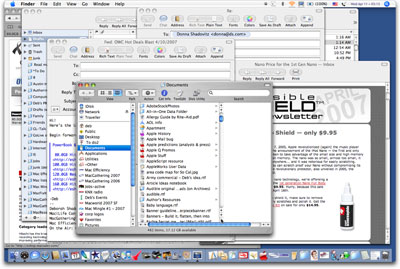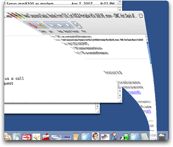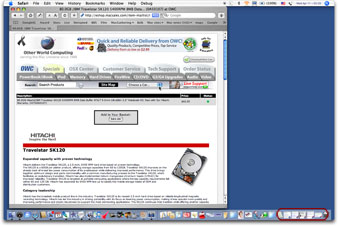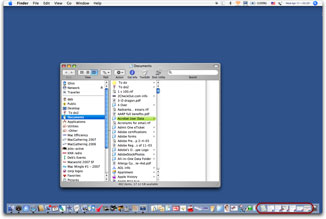[This article was written to cover OS 10.4.x, aka Tiger. The look of the Dock changes in 10.5.x, Leopard. However, the behaviors here remain the same.]
The Dock Part 3 - Minimizing and Hiding
If you open only one document at a time and look at nothing else while that is open, you can skip this article.
But, if you tend to jump between several documents within any program
and/or jump between programs, read on because this may make your Mac experience easier.
Imagine...
You're working in Apple's Mail app (or Entourage or Eudora).
You have the main Message Viewer open, plus five separate email windows open because you're referring to two incoming messages and composing a few outgoing message.
You need to check a website, so you click Safari in the Dock, open a new browser window, and go to that site.
But you need to look something up on your hard drive, which means opening a Finder window.
 However,
However,
your Desktop
is so full
that
you can't focus!
(Try finding anything on this crazy screen shot.
I could not work this way.)
What can you do to make this easier?
Let's revisit that scenario...
Minimize Open Files
You could dock all those Mail windows.
While you're in Mail, after you've read one of your open emails...
1) click the yellow button on its window.

2) which minimizes the window to the Dock.
(The genie effect)

 So, instead of an item open on your Desktop, you just have a miniature rendition of it in the Dock. When you mouse over that miniature you'll see the file's name.
So, instead of an item open on your Desktop, you just have a miniature rendition of it in the Dock. When you mouse over that miniature you'll see the file's name.
 Do this for each of the emails that you want to have open for easy reading soon, but don't need in view right at the moment. You can also do it for the entire main Mail Viewer window, as is done in this screen shot.
Do this for each of the emails that you want to have open for easy reading soon, but don't need in view right at the moment. You can also do it for the entire main Mail Viewer window, as is done in this screen shot.
This way you can move to Safari and read a browser window without the distraction of many emails behind it.
 Then, after you read the Safari window, if you want to keep that handy too, minimize it too, as is done in this screen shot.
Then, after you read the Safari window, if you want to keep that handy too, minimize it too, as is done in this screen shot.
This way, when you open the Finder window, there isn't a bunch of stuff distracting you. You can also minimize any Finder window too, so you can easily get back to it as well.
or...
Hide Applications
Hiding
Pressing Option as you click on an app in the Dock hides the app that you are currently in and moving away from. If you keep hiding apps as you move to the next one, you don't have Desktop or Dock clutter.
While you're in Mail, instead of just clicking Safari in the Dock — press the Option key as you click that Safari icon.
This hides the Mail app — all of its windows and menus — while bringing Safari forward.
No more Mail clutter to distract you.
Now you can find what you need in Safari.
Then you might also want to hide Safari as you move on to the next part of that task.
Open the Finder window by pressing Option and clicking on the Finder icon in the Dock.
There's no exciting screen shot to show you for this. You simply have a Dock with the Safari icon showing (or translucent if due to a utility setting) and you have an easy-to-see Finder window open. You would not even see a bunch of email icons minimized into the Dock. (Keep reading.)
Let's look at these two helpful features in detail now.
Minimizing: Out of Sight — and out if mind, or not
If you were in the United States any time between 1965 and 1970, you probably dreamt of Jeannie and recall how she’d blink herself into her bottle when it wasn't cool for her to be seen.
OS X gives your very own documents, browser windows, email windows, and Finder windows that same ability. We don't get the great pink smoke, but we do get to see our open items funneled into our Dock where they await miniaturized.
Minimizing lets us keep files and windows open, but puts them out of our way so we can:
- concentrate on one file but quickly refer to another.
- concentrate on one task, then quickly return to another.
These documents are still open. They're just out of your way, waiting in the Dock. All you have to do to get them back open on your screen is click on their miniature icons in the Dock. If you can't tell which file is which in the Dock moving your mouse over each icon shows you the file's name.
Ways to Minimize
- Click the Window's yellow button
- Double-click anywhere in the window's Titlebar
- Type Command-M
Ways to Open the Document Window Again
- Click the file's icon in the Dock
- Press Command (Apple) and Tab until you arrive at that document’s app — but only if it was the last document of that application type to be minimized.
Hiding
I always say your computer is like your filing cabinet. Have you ever had a bunch of documents lying open on your filing cabinet, then had guests — and perhaps wished you could blink your eyes and have all your files be invisible while your company comes into your office! Well, to the best of my knowledge, we can't have that in the physical world, but we can easily hide our Mac files when we simply wish not to see them.
At any time while you are working, you can hide all of your open files within any application. All of that app's pages that are open on your Desktop will hide, and even the ones that are minimized in your Dock will disappear. They are really still on your Mac, of course, and are still open and waiting to be working on — by they become invisible until you unhide, them again.
Ways to Hide
- Press Option as you click an App icon in the Dock
- Keep the mouse pressed as you click an App icon in the Dock, then choose Hide from the resulting menu.
- Press Command(Apple) and the H key.
(Command-h does not work with Adobe Creative Suite apps as they use that combo for something else.)
Ways to Unhide
- Click the App icon in the Dock
- Press Command (Apple) and Tab until you arrive at that app.
Combine minimizing and hiding!
Minimizing is a quick and easy way to get a document out of your way, yet see that it's still around for you. I use it often. However, when you have a a bunch of minimized docs in your Dock, the icons there all shrink so it may become hard to see anything in your Dock. The solution... combine abilities.
Here's where it gets very cool. When you hide an app, all of it's elements hide. If you have 6 minimized emails in the Dock when you hide the Mail app, all of those 6 emails disappear from the Dock, and your other Dock items grow because there's more room again.
To demonstrate, here is the same exact Dock 3 ways.
With minimized emails and Safari windows.
![]()
Now with Mail hidden.
![]()
Now hiding Safari as well.
![]()
So, minimize when convenient. Hide at times, too. It's not one or the other.
With what I consider to be a one-window app like Address Book, iCal, iPhoto, or System Prefs, I simply choose to hide the window because to minimize either simply takes up an extra space in the Dock. (The same goes from Password Wallet, a shareware I rely on daily.)
But, when it's an app that has a lot of windows, like Safari, Mail, TextEdit, or my word processor, you may be working on one document in that program while not wanting to close others. Hiding won't work because you need to work with that app, so minimizing is appropriate.
Things to know about Minimizing
Here are some more things you may want to know about minimizing.
There is one feature of minimizing that drives me crazy:
You've minimized a page or two within an app. Perhaps a couple of web pages in Safari. Now, you want to go to a new website, so you click the Safari icon in your Dock to then press Command-N for a new browser window. But... annoyingly, a minimized window pops up out of the Dock! You don't want it, but Apple assumes you do, so it presents it. (I hope this "feature" ends in Leopard, but I don't hold much hope for that.)
There is a way around this annoyance though... Apple also lets you get to any running program by pressing Command and Tab. Keep Command down, then press Tab and press it again to move to the next running app. When you Command-Tab to an app, no window pops out of the Dock!
Anyway, various programs behave differently. For example...
- Mail: With the Mail app, the main Message Viewer window always pops out of the Dock when you click the Mail icon on the Applications side of your Dock. The way around this is to either click the desired minimized message, or to click and hold on the Mail app icon and choose Compose New Message. Or, Command-Tab to Mail, then choose your command or window.
- Safari: With Safari, when you click the Safari icon in your Dock, and have several pages minimized, the first page that you opened is the one that pops up, even if it was not the last page that you minimized. Why it is not the last page is beyond me! To get around the annoyance either click the desired minimized page or if you're wanting to go to a new website, click and hold on the Safari app icon and choose New Window instead of just clicking the Safari icon. Or, Command-Tab to Safari, then make your choices.
- FileMaker Pro (also an Apple app) does not open any minimized windows. Kudos to the programmers!
- Microsoft Word and Mariner Write (another cool word processor), more logically, present the last file that you minimized. And with both of these apps, if you Quit and have unsaved docs minimized, they are presented in order, from most recent to oldest for your to-be-saved consideration.
Quitting and Relaunching
When you Quit an app it's documents leave the Dock. In some programs, such as Safari, the minimized windows don't return. But in Mail, for example, they do return to the Dock.
Browsers and tabs
Browsers enable you to have multiple pages in one window by creating Tabs. When a browser window with many tabs is minimized the front tab's page name appears as you mouse over the minimized icon in the Dock.
Minimizing Effect
While you're looking at the Dock preferences, you'll see Minimize using and a popup menu that says Genie Effect or Scale Effect. When Steve Jobs first showed the Genie Effect in a Macworld Expo Keynote, he had fun with it — and it's still fun. It's function will be clearer as you complete this series of Dock articles. I recommend keeping the Genie Effect because it lets you see exactly where your item is minimizing to.
Things to know about Hiding
Here are some more things you may want to know about hiding.
Quitting Hidden Apps
You may find that some programs don't like to be Quit when they are hidden. If you click and hold on these app's Dock icons, you may see Force Quit instead of just Quit. (I find this happens with Adobe apps.) In this case, click the icon to make the app visible, then Quit it. (Command-Q is the fastest way to Quit.)
Seeing that a Program is Hidden
Using a Utility, you can make my App's icons translucent in the Dock when they are hidden. I love being able to easily see that a program is hidden.
Two utility apps that can do this for you are:
- Cocktail, $15 shareware — under Interface, then Dock
- MacPilot, $19.95 — under Dock
- OnyX, freeware — under Parameters, then Dock
Power Tip: Don't Quit
Instead of quitting apps when you're done using them, hide them instead. That way they're still running and ready when you need them again. This is particularly helpful with Address Book or iCal — apps you need to access here and then throughout your day. They don't use a lot of ram or tax your system, so they're easy to keep open.
WindowShade
In OS 7, 8 and 9 if you double-clicked on an item's title bar it Window shaded. If you miss that feature you can get WindowShade, by the Unsanity team. It's just $10 (current as of 4-07).
Exposé
There are other options as well, which I’ll cover later. Meanwhile, just know that another option is Exposé, which is built into OS X. You’ll find it in System Preferences. I love Exposé and rely on it daily.
If you're like me, Command-H and Command-M will become as automatic as Command-S (save!!) — and whenever you see a friend's Mac, you'll have an overwhelming urge to start hiding and minimizing.
Until next time...PS: If you like this article and want more, please sign up to receive a simple email each time I publish a new piece. It's easy.
Thanks to...
Exam Professor and MacSpeech
for sponsoring this article.





